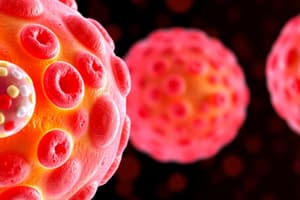Podcast
Questions and Answers
What type of trait is TPMT inherited as?
What type of trait is TPMT inherited as?
- Autosomal recessive (correct)
- Mitochondrial
- X-linked recessive
- Autosomal dominant
What percentage of homozygous children require a dose reduction of mercaptopurine?
What percentage of homozygous children require a dose reduction of mercaptopurine?
- 75%
- 91% (correct)
- 50%
- 25%
What is the purpose of CNS prophylaxis in ALL cases?
What is the purpose of CNS prophylaxis in ALL cases?
- To prevent central nervous system relapse (correct)
- To prevent bone marrow relapse
- To prevent heart failure
- To prevent liver damage
What is the name of the chemotherapy used in CNS prophylaxis?
What is the name of the chemotherapy used in CNS prophylaxis?
What is the name of the disease being treated in this pharmacotherapy?
What is the name of the disease being treated in this pharmacotherapy?
What is the main reason for CNS prophylaxis in ALL cases?
What is the main reason for CNS prophylaxis in ALL cases?
What is the effect of heterozygosity on mercaptopurine dosage?
What is the effect of heterozygosity on mercaptopurine dosage?
What is the purpose of dose reduction in homozygous children?
What is the purpose of dose reduction in homozygous children?
What is the relationship between genetic polymorphisms and enzymatic activities?
What is the relationship between genetic polymorphisms and enzymatic activities?
What is the mode of administration of methotrexate?
What is the mode of administration of methotrexate?
Flashcards are hidden until you start studying
Study Notes
Leukemia Definition and Classification
- Leukemia is a malignant progressive disease characterized by the bone marrow producing increased numbers of immature or abnormal blasts.
- Hematopoiesis is the production of all types of blood cells, including formation, development, and differentiation of blood cells.
- There are three lineages of blood cells: red blood cells (erythrocytes), lymphocytes, and myeloid lineage cells.
Pathophysiology
- Leukemia occurs due to the arrest or failure of differentiation steps in the production of blood cells.
- This arrest can be caused by chromosomal aberrations, genetic abnormalities, and other factors.
- As a result, there is a marked decrease in the production of normal blood cells, leading to anemia, thrombocytopenia, and neutropenia.
- The rapid proliferation of immature cells leads to their accumulation in the bone marrow, blood, and other organs.
Classification of Leukemia
- Leukemia can be classified into two main types: Acute Lymphocytic Leukemia (ALL) and Acute Myelogenous Leukemia (AML).
- Morphologic and cytogenetic analysis of bone marrow and peripheral blood samples distinguishes between the two types and their subtypes.
- Flow cytometric evaluation is used to characterize the type of leukemia and detect specific chromosomal rearrangements.
Clinical Presentation
- Laboratory and diagnostic tests include bone marrow aspirate, bone marrow core biopsy, and flow cytometric evaluation.
- Symptoms may include fever, infection, and metabolic imbalances.
- Patients may require transfusion support, broad-spectrum antibiotics, and correction of metabolic imbalances.
Pharmacotherapy
- The goal of pharmacotherapy is to eliminate all clinical evidence of disease and restore normal hematopoiesis.
- Treatment regimens vary depending on the type of leukemia and risk category.
- Remission induction, intensification, maintenance, and CNS prophylaxis are stages of pharmacotherapy.
- Medications used may include corticosteroids, methotrexate, and 6-mercaptopurine.
Studying That Suits You
Use AI to generate personalized quizzes and flashcards to suit your learning preferences.




